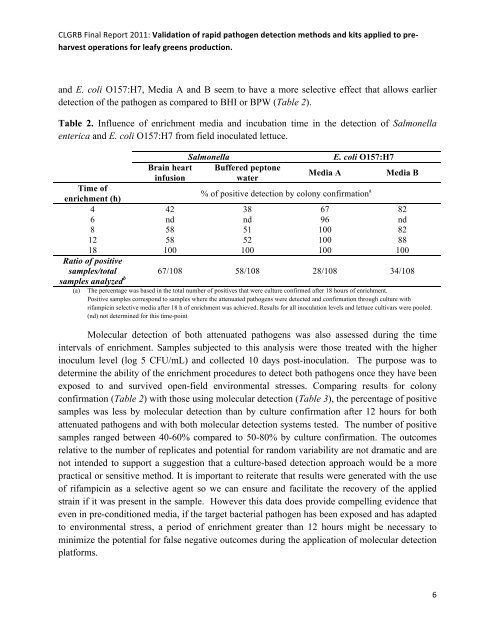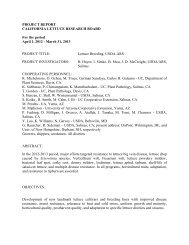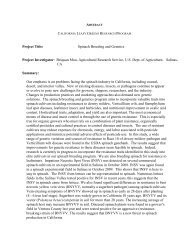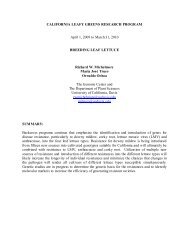Food Safety - Pathogen Detection Kits - California Leafy Greens ...
Food Safety - Pathogen Detection Kits - California Leafy Greens ...
Food Safety - Pathogen Detection Kits - California Leafy Greens ...
You also want an ePaper? Increase the reach of your titles
YUMPU automatically turns print PDFs into web optimized ePapers that Google loves.
CLGRB Final Report 2011: Validation of rapid pathogen detection methods and kits applied to pre-harvest operations for leafy greens production. and E. coli O157:H7, Media A and B seem to have a more selective effect that allows earlierdetection of the pathogen as compared to BHI or BPW (Table 2).Table 2. Influence of enrichment media and incubation time in the detection of Salmonellaenterica and E. coli O157:H7 from field inoculated lettuce.Brain heartinfusionSalmonellaBuffered peptonewaterMedia AE. coli O157:H7Media BTime ofenrichment (h)% of positive detection by colony confirmation a4 42 38 67 826 nd nd 96 nd8 58 51 100 8212 58 52 100 8818 100 100 100 100Ratio of positivesamples/totalsamples analyzed b 67/108 58/108 28/108 34/108(a)The percentage was based in the total number of positives that were culture confirmed after 18 hours of enrichment.Positive samples correspond to samples where the attenuated pathogens were detected and confirmation through culture withrifampicin selective media after 18 h of enrichment was achieved. Results for all inoculation levels and lettuce cultivars were pooled.(nd) not determined for this time-pointMolecular detection of both attenuated pathogens was also assessed during the timeintervals of enrichment. Samples subjected to this analysis were those treated with the higherinoculum level (log 5 CFU/mL) and collected 10 days post-inoculation. The purpose was todetermine the ability of the enrichment procedures to detect both pathogens once they have beenexposed to and survived open-field environmental stresses. Comparing results for colonyconfirmation (Table 2) with those using molecular detection (Table 3), the percentage of positivesamples was less by molecular detection than by culture confirmation after 12 hours for bothattenuated pathogens and with both molecular detection systems tested. The number of positivesamples ranged between 40-60% compared to 50-80% by culture confirmation. The outcomesrelative to the number of replicates and potential for random variability are not dramatic and arenot intended to support a suggestion that a culture-based detection approach would be a morepractical or sensitive method. It is important to reiterate that results were generated with the useof rifampicin as a selective agent so we can ensure and facilitate the recovery of the appliedstrain if it was present in the sample. However this data does provide compelling evidence thateven in pre-conditioned media, if the target bacterial pathogen has been exposed and has adaptedto environmental stress, a period of enrichment greater than 12 hours might be necessary tominimize the potential for false negative outcomes during the application of molecular detectionplatforms.6









